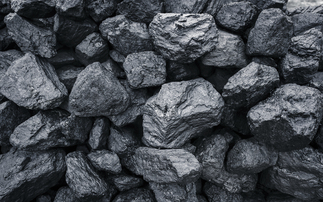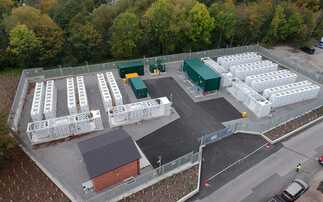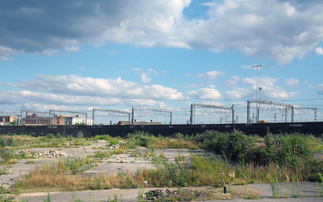Tucked away on the north-eastern edge of Brazil is Rio Grande do Norte, a kitesurfing hotspot. Adrenaline junkies travel from around the world to zip along the miles of golden beaches, propelled by the steady, consistent winds that blow along the foreshore all year round.
Many of the beach villages along the coastline are now dotted with 'pousadas', where the kitesurfers spend the evenings drinking beer in beachside bars and listening to the sound of the waves crash against the sand.
But the region's bountiful natural resources means a new type of industry is starting to spring up along this coastal hideaway. An industry which involves fewer flip flops and more hard hats.
Lured by the falling cost of turbines and the steady winds from the North Atlantic, a number of shiny new wind farms have sprung up in recent years.
Just outside the tiny beachside town of São Miguel do Gostoso is the São Benedito Wind Farm, an 115MW project from Brazilian green energy developer CPFL that opened last year. The 80-metre turbines rise up from the sun-baked plains that lie just a few kilometres behind the sand dunes, providing a stark contrast to the crude bungalows, willow fences, and dirt roads that charactierise the nearby villages.
São Benedito Wind Farm | Credit: Incisive Media
Brazil only recently woke up to its wind potential. For decades the country has relied on massive hydroelectric dams for three-quarters of its electricity supplies, with around 160 dams in operation across the country. It means for a country of its size Brazil's energy-related emissions are comparatively low, with the majority of its greenhouse gas emissions instead caused by deforestation.
We have to protect the Amazonic region - Eduardo Azevedo, Ministry of Mines and Energy
But Brazil's historic reliance on hydropower led it to becoming complacent when it comes to the development of other renewable energy technologies. While other developing nations leapt on the solar and wind energy bandwagon as soon as prices started to drop in the mid-2000s, Brazil instead pressed ahead with a programme of new hydroelectric dams to meet growing demand for power.
However, that programme has now been forced to a halt, as a combination of fierce droughts and growing public opposition has combined to make large dam development politically challenging. One of the latest mega dams to open in Brazil is the Belo Monte dam in the Amazonian state of Pará. Still under construction, the first turbines opened in December 2016 and when finished next year it is set to be the third largest dam in the world, with a capacity of over 11GW.
But its power comes at a cost. The project, which boasts a price tag of around $18bn, has led to the forced relocation of 30,000 local peoples from the Xingu River in the Amazonian and the flooding of large swathes of land, much of it biodiversity hotspots.
Protestors demonstrate against the Belo Monte dam | Credit: International Rivers
The tragic failure of Fundao dam in the state of Minas Gerais in November 2015, when a tailings dam operated by the Brazilian mining company Samarco collapsed drowning 19 people in a tidal wave of mining waste and leaving hundreds more homeless, has provided further ammunition for anti-dam activists.
Meanwhile changing weather patterns have led to droughts in key power generating areas, rendering hydropower less reliable and more expensive.
Now energy experts across Brazil acknowledge the era of the super dam might be coming to an end. "We have to protect the Amazonic region," acknowledges Eduardo Azevedo, secretary of planning and energy development at the Ministry of Mines and Energy, at a meeting with BusinessGreen and other media outlets last month.
Andre Pepitone, director of Brazilian electricity regulatory agency ANEEL, agrees, pointing out that most of the country's remaining hydro resources are in the Amazonian region and therefore cannot be developed.
"We have to think about some innovation," he says, citing the development of more small hydro and wind and solar projects. Such innovation in clean energy will be necessary to stop the generation gap being filled by fossil fuels. In 2011, when hydropower generation peaked in Brazil at 428TWh, gas generation was at 25TWh and coal 12TWh. By 2014, the latest year generation data was available for, gas generation had climbed to 81TWh and coal to 35TWh.
But the strength of Brazil's wind resources make turbines an attractive alternative to fossil fuels. According to Sandro Yamamoto, technical director of Abeeolica, the country's wind industry trade body, if two identical wind projects were built in north-east Brazil and China, the Brazilian project would generate double the amount of clean electricity.
It is this lure of high yields, as well as the global drop in price of onshore wind technologies, that has fuelled the industry's expansion in Brazil in recent years. Since the first government energy auction for wind power in 2009, 13GW of capacity has been installed, with almost 11GW of that in the north east. That now puts Brazil at eighth in the world for installed wind capacity. By 2023, Abeelica expects 17.88GW of wind power to be operational.
Wind supporters also note that wind power complements the seasonal changes in hydro production, which ebbs away between March and October during the country's drier period. "When it doesn't rain in Brazil the hydro has less power but the winds are more powerful," says Abeeolica's Yamamoto.
But wind's development is not only about replacing hydro in the green power stakes. It also offers the rural regions of Brazil a much needed economic boost. The Rio Grande do Norte, the region that is home to the São Benedito Wind Farm among many others, is one of the poorest states in Brazil. Eight years ago there was no wind power in the region, and the state was a net importer of electricity. Now it is a net export for energy, and economic growth is returning to the area.
According to CPFL, on average 1MW of wind installed delivers 30 jobs - not only from the construction and maintenance of the project itself but also via the ancillary benefits from the development, such as land rent income, increased spending power for migrant labourers, and tax receipts for the local municipality. The impact of CPFL's activity in Rio Grande do Norte specifically has been quite dramatic, says Ricardo Barbosa, director of operations at CPFL. It is a rural state with little industry, so this has become quite a major economic boon for the state, he tells reporters visiting São Benedito.
That's partly why the Brazilian government is keen to drive investment in wind; not just to build out the country's renewables capacity but establish new growth industries beyond the country's traditional economic powerhouses of agriculture, sugar, and mining.
We are trying to replicate the last eight years of growth for the wind industry, for the solar industry - Maria Luisa Cravo, Apex-Brasil
As part of the renewable energy auctions, which contract power for wind energy as well as solar, small hydro and biomass generation, the Brazilian development bank BNDES offers subsidised loans for up to 80 per cent of the project cost. Developers taking up such an offer must meet local content requirements of about 65 per cent for their projects - a condition which has helped Brazil quickly establish a relatively comprehensive manufacturing supply chain for the wind industry, which supports 80 per cent of wind farm projects in the country and now has its eyes on the Latin American export market.
Meanwhile, Apex-Brasil, the Brazilian trade and investment promotion agency, has targeted renewable energy as one of its priority sectors for attracting foreign investors. It works from Brasilia and a network of 10 international offices to lure capital into the country, offering potential investors local connections, advice, and even help finding the right site for their projects.
The strategy seems to have worked for wind power, which now delivers around eight per cent of the country's electricity supply.
Now the country is hoping to repeat the same trick with solar. The sector presents a similar story to wind - plunging energy costs combine with high levels of natural resources, in this case irradiation, making for an attractive market opportunity. "What we are trying to do now is replicate the last eight years of growth for the wind industry, for the solar industry," says Maria Luisa Cravo, investment manager at Apex-Brasil.
But if Brazil was a little late to the global wind boom, it's even further behind the curve with solar. According to Rodrigo Lopes Sauaia, CEO of solar trade lobby ABSOLAR, investment only kicked off from 2013 onwards, more than a decade after the global industry started to scale up.
But Brazil is now scrambling to catch up. By the end of the year Sauaia expects the country to hit 2GW of installed capacity and he has high hopes it can quickly propel itself into the top 10 of international solar markets.
Testament to this rapid growth is the Pirapora solar complex in Minas Gerais, one of the country's first large scale solar farms which is currently nearing the end of its construction phase. Down a remote, bumpy track, through a stretch of old eucalyptus fields, lies the acre after acre of solar panels that constitutes developer EDF Energies Nouvelles (EN)'s largest-ever solar venture.
Phase three of the park is due for completion later this year, when a total of 1.2 million panels will be up and running. When EDF took over the site from Canadian Solar in 2016, the country was still relatively inexperienced in solar technology, according to Paulo Abranches, CEO of EDF's renewable power subsidiary EDF EN in Brazil. "Now things are changing and the industry is becoming much more consolidated," he tells BusinessGreen during a meeting at the Pirapora complex.
Pirapora solar complex | Credit: EDF
There are even suggestions of a push to deliver hybrid parks, where wind and solar co-exist. The first such park opened near Sao Paulo in 2013, and Azvedo from the Ministry of Mines and Energy hints more could be in the pipeline, with a dedicated auction under consideration for the near future. "We are trying to explore this model further in the future," he confirms. "There is an opportunity to complement one source with another and improve our grid."
CPFL's Ricardo confirms the market interest in hybrid parks, telling BusinessGreen that, like other renewable developers in the country, CPFL is "definitely" looking at the potential of augmenting wind projects with solar power. EDF says it is also considering the possibility, but Paulo admits there is difficulty in finding the right sites. However, the north east could be a good starting point for any search - the region with the steadiest wind speeds throughout the year is also one of the sunniest parts of the country.
B
ut the march towards greener energy isn't all plain sailing. Recent investors in Brazil have had a bumpy ride.
First came the Lava Joto, a major political corruption scandal that shocked Brazilian citizens - and swept the country's political class off its feet. At the core of the scandal was the allegation that swathes of politicians and some of the country's largest businesses had inflated public contracts, with kickbacks then making their way into political campaign funds. There were even reports the construction of the Belo Monte mega-dam was pushed through against staunch opposition because it was involved in a deal to funnel $41m of donations to the ruling coalition.
The scandal led to massive political and business upheaval in Brazil. Although no evidence suggested former President Dilma Rousseff was directly involved in the scandal, she was impeached in 2015 for allegedly window-dressing government accounts ahead of the last general election. Former President Luiz Lula Da Silva has seen his hopes of winning another presidential term all but dashed as he faces a lengthy prison sentence for corruption offences.
Meanwhile tenders for some large public contracts have stalled, causing major disruption to supply chains and putting many smaller manufacturing outfits out of business.
Apex-Brasil insists President Michel Temer, who took over from Rousseff in 2016, has introduced a series of reforms designed to improve the reputation of Brazilian politics. According to Cravo, they include a series of spending cap reforms to ensure no additional growth in public spending for the next 10 years, labour reforms to help make companies more efficient, time delays between energy auction bidding rounds and results, and new requirements for appointed heads of government agencies to have relevant experience.
"We have seen throughout President Temer's administration an extensive reform agenda which is targeting fiscal balance and sustainable growth," she says.
A worker at the PiraPora solar complex | Credit: Incisive Media
But many young people in the country remain sceptical of both politicians and industry, and Temer's popularity ratings lie forlornly in the single digits just months before a general election that looks set to deliver another massive wave of political upheaval.
Meanwhile, Brazil has only just emerged from a bruising two-year recession where GDP dropped seven per cent, and although the economy is recovering growth hovered at just one per cent in 2017.
The knock-on impact for the energy sector has been substantial. The slump in economic growth meant energy demand forecasts were revised downwards, leading to the government suddenly cancelling clean energy auctions in 2016 and 2017. This meant delays for wind and solar developers - CPFL was just one player forced to wait for auctions to resume late last year to re-bid for its projects - and could spell a hiatus in contracts for newly built manufacturing plants.
However, the cancellations have had the unintended consequences of forcing clean power prices down close to a level comparable with other countries around the world. The latest solar auction in April 2018 delivered an average price of BR118.07 per MWh (US$35.25), compared to an average price of BR301.79 (US$84.15) per MWh in the August 2015 auctions. Meanwhile, the April 2018 wind auctions priced wind power at BR67.6 per MWh (US$20.23), compared to BR203.46 per MWh (US$52.9) in 2015.
And despite its recent ups and downs, Brazil remains keen to be seen as a climate leader. Its climate pledge published ahead of the Paris Agreement talks in 2015 was the only one from a developing nation to promise an absolute reduction in emissions, pledging to cut emissions 37 per cent below 2005 levels by 2025, with an "indicative" 43 per cent cut targeted for 2030. Most emerging economies, including India and China, opted instead for a promise to peak their emissions by a certain date - a tactic Brazil had also employed at previous negotiations.
In the years since 2015, Brazil has maintained its public commitment to cutting emissions and leading on other environmental issues. On World Water Day in March, Temer boasted of Brazil's role as one of the first country's to ratify the Paris Agreement and promised to take more action to preserve the country's water resources.
However, campaigners point out that Brazil's NDC climate action plans is not quite as cut-and-dried as it first appears. According to government data Brazil's emissions were already 41 per cent below 2005 levels in 2012, thanks in large part to major efforts to slow illegal deforestation in the country. This meant Brazil had already technically achieved its 2025 and 2030 pledges, and under its promise has actually allowed for emissions to rise in the 2020s before falling back to around 2012 levels by 2030.
Meanwhile, some environmentalists argue recent changes to the Forest Code serve to "invite" an uptick in deforestation by cutting restoration requirements on farmers holding deforested land - although defenders of the reform argue it actually embeds tougher requirements on forest preservation.
São Benedito Wind Farm | Credit: Incisive Media
But despite some lingering doubts Brazil's trajectory is clear. It is moving away from large hydropower, and is determined to meet its growing energy demand without significantly expanding its fossil fuel energy base.
It also has the bountiful natural wind and solar resources that mean it has the potential to become a world leader in these technologies.
For international clean energy developers and investors, that spells a major opportunity, even if the quirks of Brazilian politics and economics may add a few bumps to the road. Like the kite surfers in Rio Grande do Norte, there will be more than a handful of adventurous trailblazers keen to ride the wave.
Madeleine Cuff's trip to Brazil was paid for by Apex-Brasil, the Brazilian trade and investment agency.








